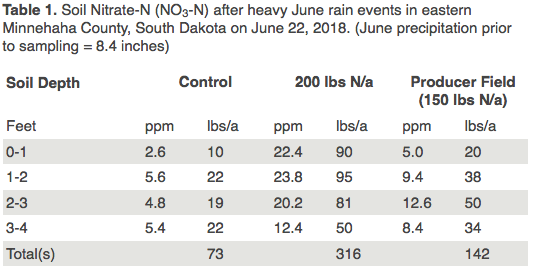Heavy rains have occurred in southeast S.D, southwest Minn. and northwest Iowa in the past two weeks. Soil nitrogen (N) in these fields should have had adequate time to convert to nitrate-N (NO3-N) and therefore be vulnerable to leaching with water movement through the soil profile.
While the soil nitrogen cycle is very complicated is it extremely hard to measure exactly the amount of nitrate that should be in the soil from fertilizer or manure N applications. However, we can get an idea if leaching has occurred by evaluating the concentrations of nitrate-N by soil depth.
A Nitrogen rate corn study began in eastern Minnehaha County S.D. in May and poses a good scenario for measuring possible soil nitrate leaching. We sampled the check plots (without fertilizer nitrogen application) and the 200 lbs N/a plots in one-foot soil depth increments to determine any possible nitrate-N leaching.
Additional soil samples were gathered from a nearby producer’s field for comparison. The soil nitrate-N analysis shows that leaching did occur (Table 1). There seems to be a nitrate-N concentration bulge in the one to three-foot soil depths, which indicates that low amounts of N were lost below the four-foot depth.
Different climate scenarios that occur in the remaining growing season will control whether the corn can extract the deeper nitrate-N. Reduced precipitation will cause corn roots to go deeper in the soil and help extract nitrate-N. Increased precipitation could cause further leaching and shallower rooting, resulting in less uptake by the corn.
At this time, the N in the one to three-foot soil depths should not be considered as lost but leads to a situation that needs further attention if precipitation remains high, as the side-dress N period is ending due to increase corn height.
Between the June 22 sampling date and the date of writing this article (June 26), 2.59 inches of additional rain occurred, for a June total (to date) of 10.99 inches.
We all know that producing a crop is risky and full of difficult decisions. Nitrate-N loss from leaching is hard to manage and this data does not provide any clear answers but hopes to provide some insight on the current situation.







Post a comment
Report Abusive Comment